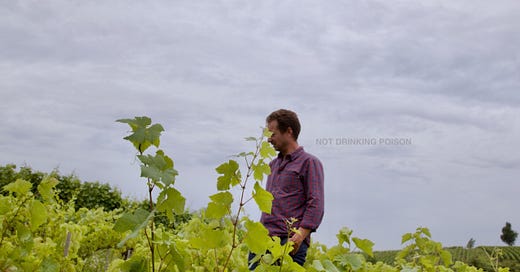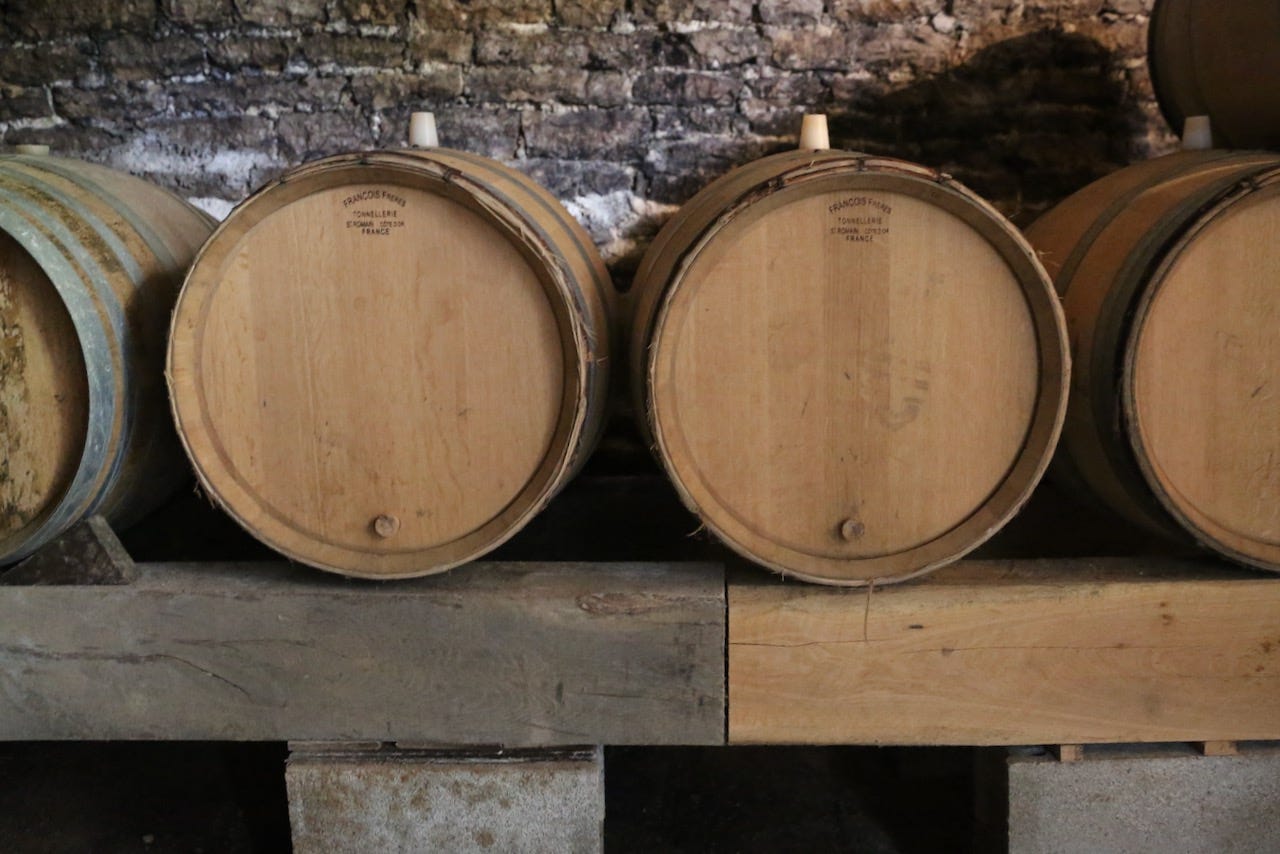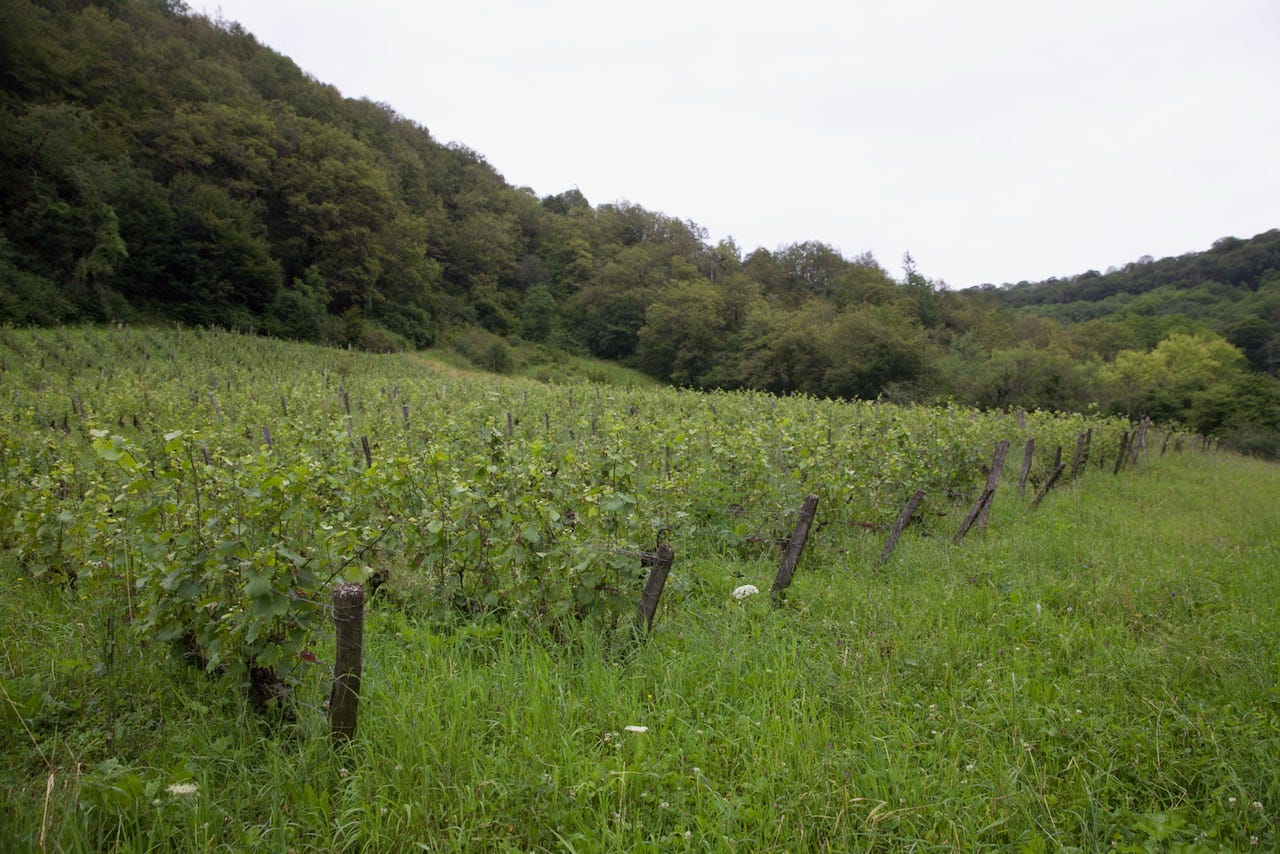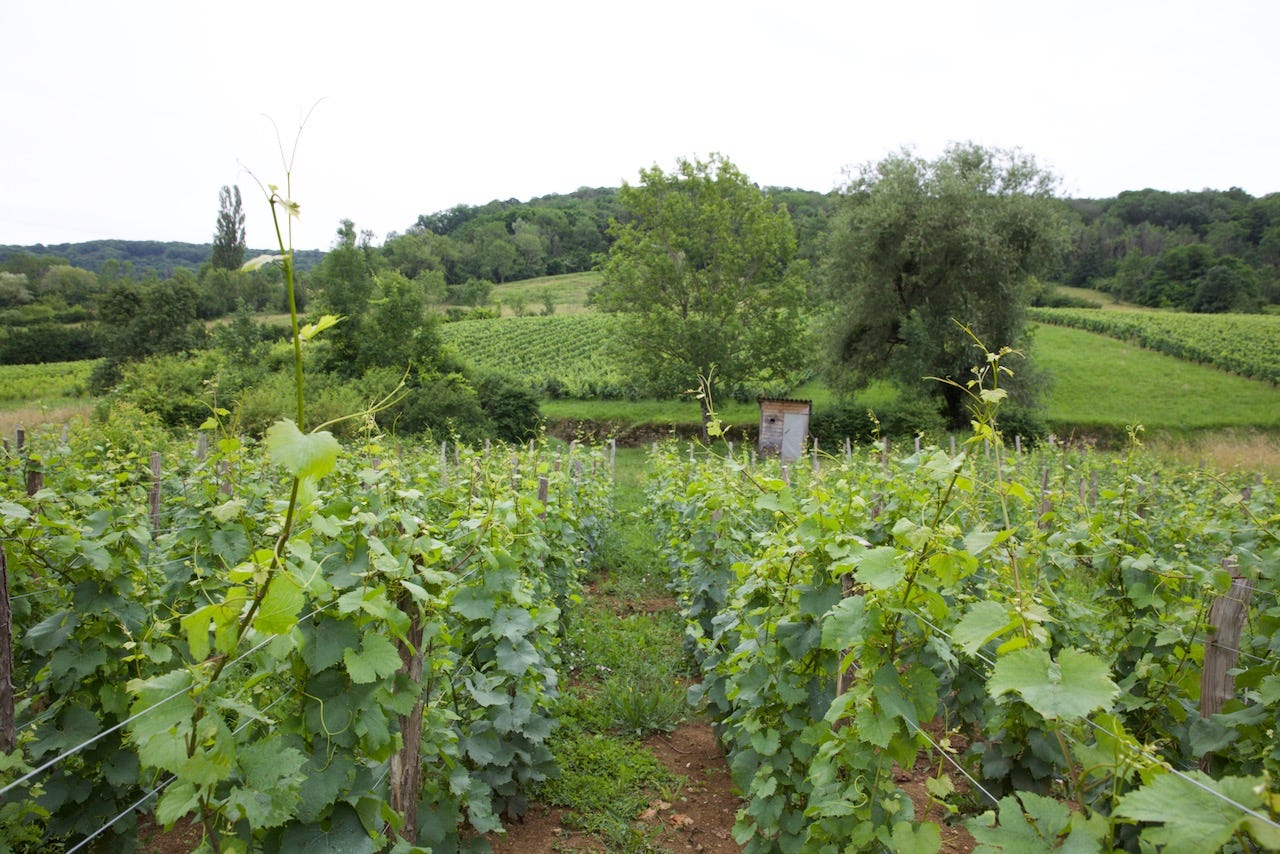Thomas Popy's House of Cards
A stroll through the parcels of Thomas Popy, the discreet, Beaujolais-born vigneron whose soaring unsulfited, unfiltered, hand-bottled wines are highlights of a new generation of Jura vignerons.
Among the first things the Beaujolais-born Jura vigneron Thomas Popy mentions, when I first visit him in July 2020 with my friends Juliette and Bert, is he generally prefers not to have his picture on the internet.1
I can see the wisdom in this. There’s basically no way to keep one’s face off the internet entirely. But it slows the avalanche a bit, and, as any good winemaker knows, the rate at which an event occurs - be it the pressing of a tank, or fermentation, or positive media coverage - is as important as the achievement of the event itself.
Popy’s attitude towards social media can be read as a reflection of the extreme patience in his working habits. Social media is by nature fast and messy. Popy’s winemaking is painstaking and precise: no pumps, a manual press, bottling by hand, barrel by barrel.
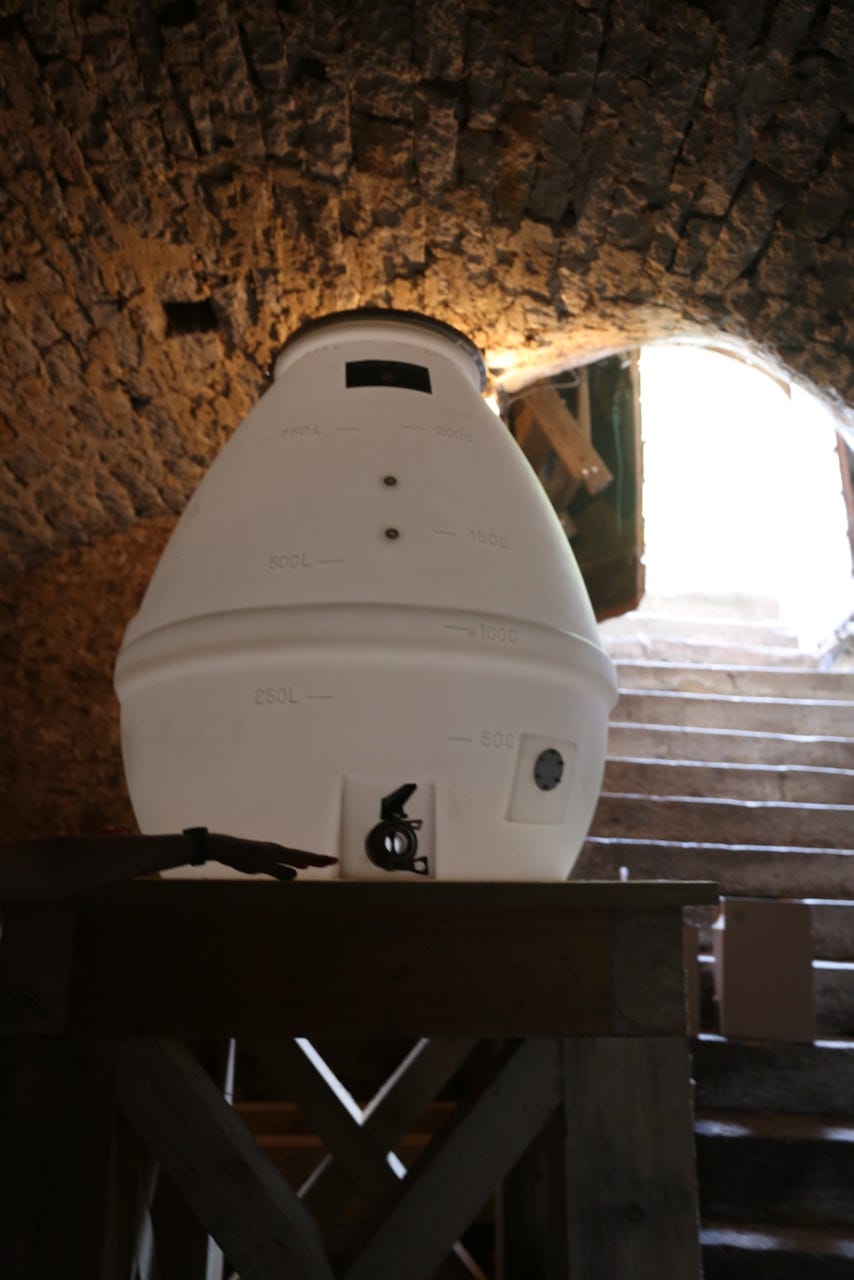
He conducts élevage for as long as the wines require, by his estimation: at least two years, and up to four for certain whites. He tends to save for personal consumption only magnums of his back vintages: it’s a method of delaying drinking them, since one rarely opens magnums on quiet evenings at home.
Popy’s rigorous, measured character belies a cutting sense of a humor about his work.
“I’ll plan to put this or that wine in bottle, and each time the whole house of cards just tumbles. It’s not me deciding. It’s the wine. But I like it this way,” he says. “Otherwise I’d just add sulfites and I’d be peaceful.
After an early job in landscaping around his native Vaux-en-Beaujolais, Popy got his start in wine through an introduction to Julie Balagny, for whom he went on to work for two years. (Balagny today rightly considers him her star pupil.) Popy went on to work for Jean-Claude Lapalu and Vauxrenard’s Michel Guignier. He says he initially considered establishing an estate in the Beaujolais, only to find that encouragement from the wine community seemed to evaporate as soon as his plans began to firm up.
“I’d found a pretty parcel near my father in Vaux, and I wanted to set up an estate,” he says. “But I just noticed, when I started to talk about it, all the people who I thought might have helped me, they weren’t there for me anymore.”
I’ve heard similar stories from other young Beaujolais vignerons. Part of the explanation is a widespread sort of Beaujolais school-of-hard-knocks mentality. But it’s also probably related to a mild sense of competition among many vignerons with wine to sell, all working from the same grape, on similar terroirs.
Popy decamped for the Jura in 2015 to do viticultural studies at Montmorot. Here he was the right man at the right time.
“At the time I knew very little of the Jura and its wines. But I had a really extraordinary welcome. All the vignerons helped me to set up, to find tools, to dialog, all that.”
Popy interned with Pierre Overnoy and Emmanuel Houillon, and went on to work for Céline and Steve Gormally of Les Dolomies and Domaine de la Pinte. Rather quickly, he acquired a rental agreement for his first parcel, “Sous la Roche Maldru,” a forest-adjacent patch of chardonnay and savagnin on limestone scree and marne overlooking Mesnay. Popy, with only a hint of wryness, calls it “the prettiest parcel in the Jura.”
“It’s an ambience similar to Julie [Balagny]’s ‘En Remont,’” he says. “There’s a forest above it, and on the sides, so it’s a terroir that’s quite fresh. The sun arrives late, it’s full south exposure. There’s always a bit of humidity. You have to harvest it quite late. Some years I’m the last in the village to harvest.”
Popy vinified his first few vintages in a garage sited near the vines of Emmanuel Lançon of Domaine des Murmurs, before moving winemaking to a cellar beneath his home in Mesnay in 2017.
After our first visit, my friend Juliette would return to intern for Popy on several occasions for weeks at a stretch. (She has a knack for acquiring internships with idiosyncratic vignerons with almost zero resources, i.e. Romuald Valot and Benoit Rosenberger.) I return to visit Popy with her almost exactly a year later, in July 2021, on the occasion of Bojalien. To my delight, my friend the Beaujolais vigneron and Bojalien organizer Romain des Grottes is also staying chez Popy; it turns out the two were longtime friends. (Des Grottes hosted Popy’s wedding at Domaine Des Grottes.)
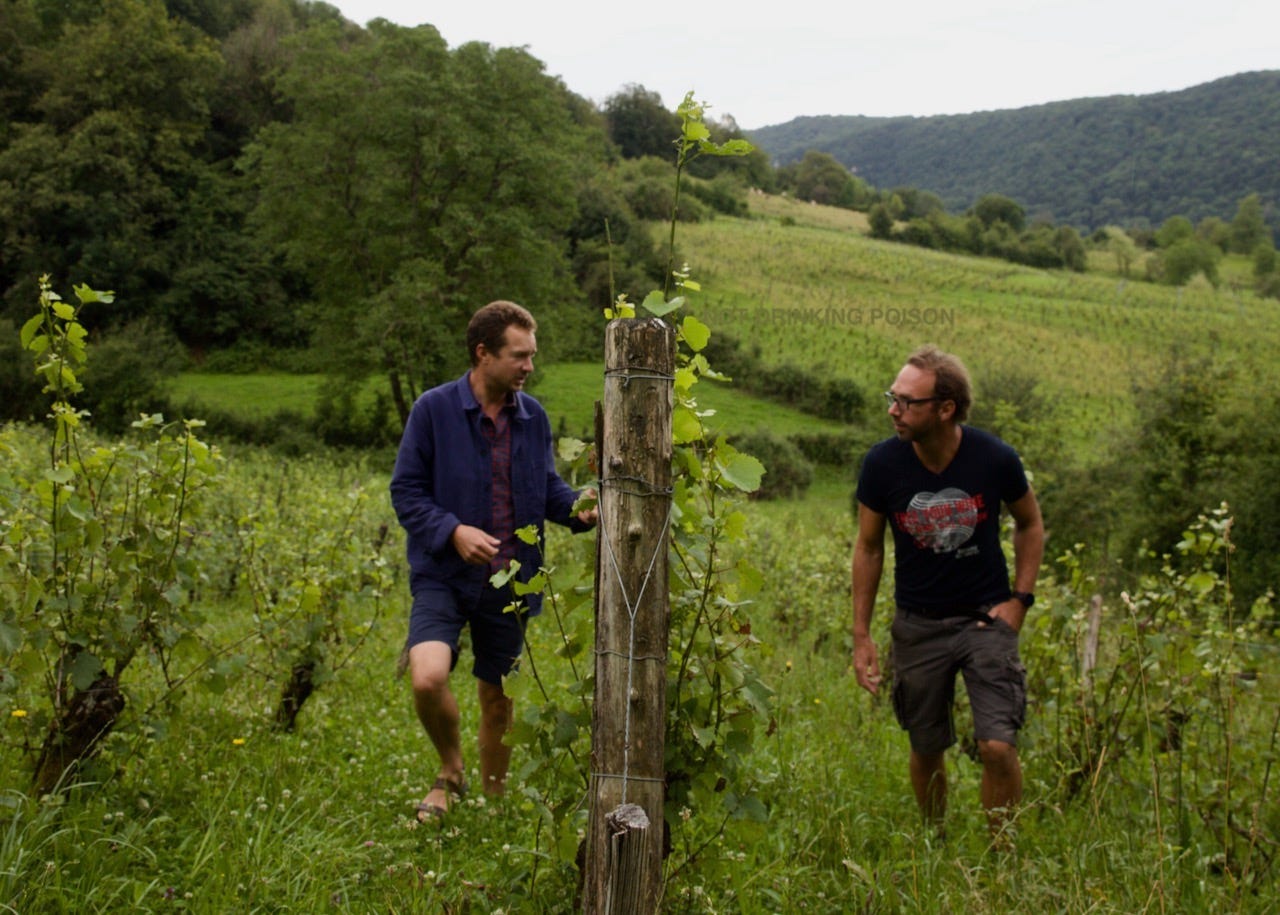
On the surface, it would be hard to find two vignerons with more divergent approaches to natural winemaking. Popy makes painstakingly crafted, long-aged moonshots that already rival the long-lived unsulfited masterpieces of his adoptive region. Des Grottes, on the other hand, has no particular fidelity to the notion that wine should be the destiny of his biodynamically farmed gamay, and is just as apt to employ it to produce non-alcoholic beverages or cider-wine concoctions. The wines he does produce are quasi-improvisational and generally bottled by the November after harvest.
Yet Des Grottes and Popy share a reflective, sober bent that makes them kindred outcasts-of-the-mind in their native Beaujolais. Des Grottes refers to him, affectionately, as a “philosopher.”
On that occasion last July, Juliette and I join the two philosophers on a stroll through Popy’s parcels. At the time he farms just over 2ha of vines, although he has since uprooted some vines, and planted another small parcel in Pupillin, from what I understand. (Popy’s patience and rigor extends to his readiness to uproot and replant with better vegetal material, despite his minuscule vineyard surface.)
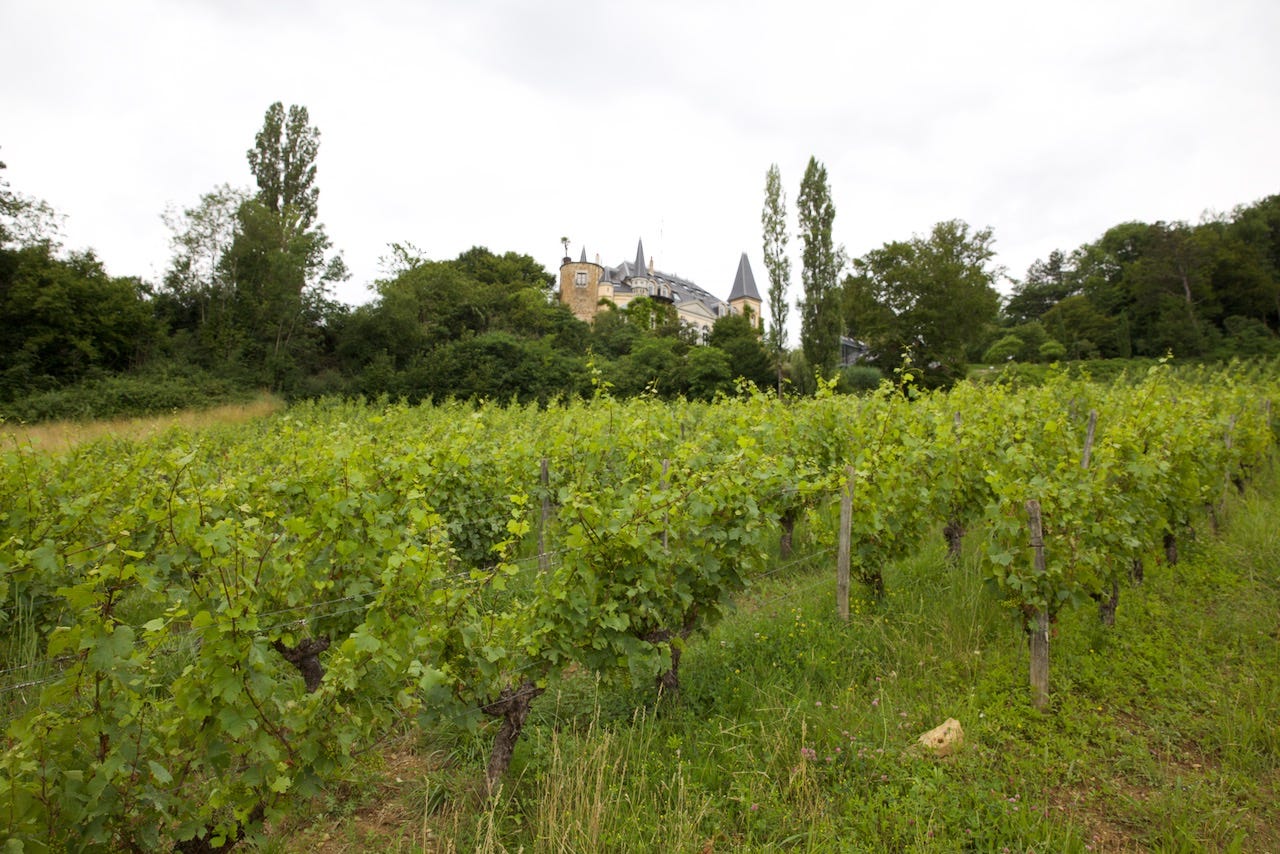
Popy also produces a red wine, “Clos Bareth,” from a parcel in Mesnay planted to trousseau and chardonnay. I taste the 2020 wine when I reencounter him early this April, at the Bamboche Chai Nous tasting organized by Julie Balagny at her home in Romanèche-Thorins. It is a purple blast of perfection, chiseled and floral, with a saline sweep of perfectly-judged CO2.
On this same occasion, I learn that between frost, hail, and mildew, Popy produced very, very little wine in 2021. Popy’s quiet Mesnay masterpieces are rarities that are about to get even rarer. He seems unconcerned. I introduce him to my friend Brice, a former physical-chemistry teacher who now works for Balagny, and we spend part of the evening polishing off a magnum of Brice’s excellent non-commercialized 2020 gamay.
I can’t help recalling what Popy said when we first met, as he was preparing to leave his part-time job at Domaine de la Pinte: he said he felt like a young retiree.
“I’m a little anxious,” he said then. “But I have the advantage of having a bit of wine in the cellar. And I don’t have too many costs. If I have to work, I’ll find work.”
Thomas Popy
5 Rue du Ruisseau
39600 MESNAY
FURTHER READING
My friend Bert Celce’s account of our first visit to Thomas Popy in July 2020 at Wine Terroirs.
A 2015 piece I wrote about Julie Balagny.
More Jura reports:
An interview with Didier Grappe on hybrid grape varieties.
Pulling wood in Katie Worobeck’s new vineyard in Saint-Laurent-la-Roche.
Issue 3.5: Reasons to be Cheerful in the Jura
He kindly implied we were exceptions.

